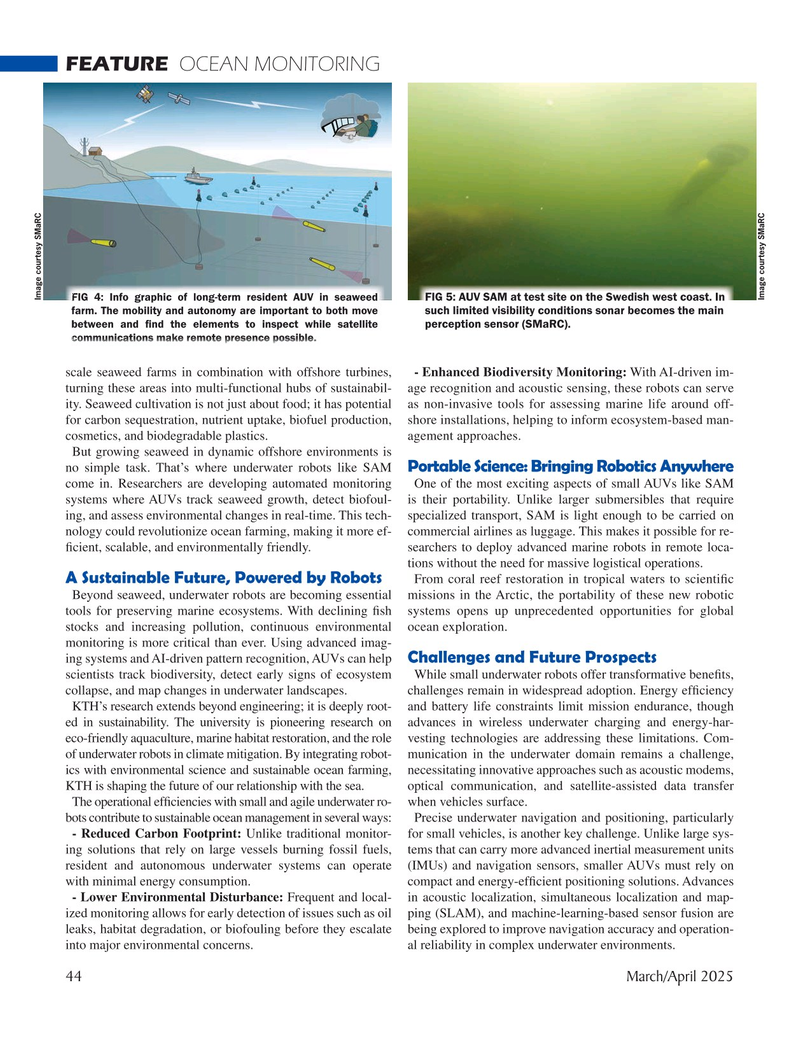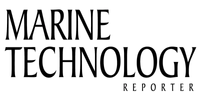
Page 44: of Marine Technology Magazine (March 2025)
Read this page in Pdf, Flash or Html5 edition of March 2025 Marine Technology Magazine
FEATURE OCEAN MONITORING
Image courtesy SMaRC
Image courtesy SMaRC
F F FIG 4: Info graphic of long term resident AUV in seaweed d d dFIG4:Infographicoflong-termresidentAUVinseaweed F F F FIG 5: AUV SAM at test site on the Swedish west coast. InFIG 5: AUV SAM attestsiteont he Swedish westcoast. In f farm. The mobility and autonomy are important to both move e s such limited visibility conditions sonar becomes the main p perception sensor (SMaRC).
b between and ? nd the elements to inspect while satellite e p ss p p p p po senc po se senc po senc po senc po senc po senc po senc po senc po mo mo mo mo mo mo mo mo ake ak ak ak ak ak ak ak ns ns ns ns ns ns ns ns u ic commun co co co commun commun commun commun commun commun commun communic ic ic ic ic ic ic icat at at at at at at at atio io io io io io io io ions s m m m m m m m m make e e e e e e e e re re re re re re re re re emo ote te te te te te te te te p p p p p p p p p p p p p p pre re re re re re re re re esenc ce e e e e e e e e e poss ss ss ss ss ss ss ss ssib ib ib ib ib ib ib ib ible le le le le le le le le. . . . .
scale seaweed farms in combination with offshore turbines, - Enhanced Biodiversity Monitoring: With AI-driven im- turning these areas into multi-functional hubs of sustainabil- age recognition and acoustic sensing, these robots can serve ity. Seaweed cultivation is not just about food; it has potential as non-invasive tools for assessing marine life around off- for carbon sequestration, nutrient uptake, biofuel production, shore installations, helping to inform ecosystem-based man- cosmetics, and biodegradable plastics. agement approaches.
But growing seaweed in dynamic offshore environments is
Portable Science: Bringing Robotics Anywhere no simple task. That’s where underwater robots like SAM come in. Researchers are developing automated monitoring One of the most exciting aspects of small AUVs like SAM systems where AUVs track seaweed growth, detect biofoul- is their portability. Unlike larger submersibles that require ing, and assess environmental changes in real-time. This tech- specialized transport, SAM is light enough to be carried on nology could revolutionize ocean farming, making it more ef- commercial airlines as luggage. This makes it possible for re- ? cient, scalable, and environmentally friendly. searchers to deploy advanced marine robots in remote loca- tions without the need for massive logistical operations.
A Sustainable Future, Powered by Robots From coral reef restoration in tropical waters to scienti? c
Beyond seaweed, underwater robots are becoming essential missions in the Arctic, the portability of these new robotic tools for preserving marine ecosystems. With declining ? sh systems opens up unprecedented opportunities for global stocks and increasing pollution, continuous environmental ocean exploration.
monitoring is more critical than ever. Using advanced imag- ing systems and AI-driven pattern recognition, AUVs can help Challenges and Future Prospects scientists track biodiversity, detect early signs of ecosystem While small underwater robots offer transformative bene? ts, collapse, and map changes in underwater landscapes. challenges remain in widespread adoption. Energy ef? ciency
KTH’s research extends beyond engineering; it is deeply root- and battery life constraints limit mission endurance, though ed in sustainability. The university is pioneering research on advances in wireless underwater charging and energy-har- eco-friendly aquaculture, marine habitat restoration, and the role vesting technologies are addressing these limitations. Com- of underwater robots in climate mitigation. By integrating robot- munication in the underwater domain remains a challenge, ics with environmental science and sustainable ocean farming, necessitating innovative approaches such as acoustic modems,
KTH is shaping the future of our relationship with the sea. optical communication, and satellite-assisted data transfer
The operational ef? ciencies with small and agile underwater ro- when vehicles surface.
bots contribute to sustainable ocean management in several ways: Precise underwater navigation and positioning, particularly - Reduced Carbon Footprint: Unlike traditional monitor- for small vehicles, is another key challenge. Unlike large sys- ing solutions that rely on large vessels burning fossil fuels, tems that can carry more advanced inertial measurement units resident and autonomous underwater systems can operate (IMUs) and navigation sensors, smaller AUVs must rely on with minimal energy consumption. compact and energy-ef? cient positioning solutions. Advances - Lower Environmental Disturbance: Frequent and local- in acoustic localization, simultaneous localization and map- ized monitoring allows for early detection of issues such as oil ping (SLAM), and machine-learning-based sensor fusion are leaks, habitat degradation, or biofouling before they escalate being explored to improve navigation accuracy and operation- into major environmental concerns. al reliability in complex underwater environments.
44 March/April 2025
MTR #3 (34-49).indd 44 3/13/2025 12:39:27 PM

 43
43

 45
45
